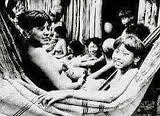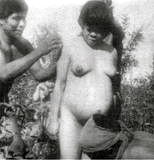The basic political unit of traditional Amazonian society is the village, larger than an extended family, but still never larger than a few hundred inhabitants. These villages are politically autonomous entities, often widely separated, several days walk from each other. When the population of a village grows too large, a portion will split off and form its own village elsewhere in the jungle.
These village political units share two striking features. First, they have no chiefs. Village members in apparent leadership roles actually have very little authority over anyone else. Second, they have historically spent much of their time fighting each other, in armed conflict that is often protracted, bloody, bitter, and cruel.
The warfare consisted — and not infrequently continues to consist today — primarily of stealthy nocturnal raids on another village, with the goal of slaughtering the inhabitants in their hammocks, except those who manage to flee into the jungle. The dispersed survivors then gather, often change the location of their village, and plot a revenge raid of their own. Anticipating such raids, many Amazonian peoples have maintained several distant gardens to which they might flee, and slept with their most important possessions close to hand.
Such Amazonian warfare appears to be very old. The Spanish invaders — professional soldiers with a sharp eye for such things — frequently remarked on the skill and ferocity of the Amazonian warriors they encountered. Ethnohistorian Linda Newson has described internecine Amazonian warfare as endemic at the time of first contact. Village raids and killings have continued into the present. As one Huaorani told anthropologists Stephen Beckerman and James Yost, “That is how we lived in the old days. Back and forth we killed. Back and forth, back and forth. Together we died.”
Why should this be?
 |
| Pierre Clastres |
French anthropologist Pierre Clastres, who died in 1977, spent two years in the early 1960s living with the Guayaki in eastern Paraguay, who were wiped out shortly after his departure — “eaten away by illness and tuberculosis, killed by lack of proper care, by lack of everything,” their women and children hunted for slaves by white settlers. His oddly disturbing ethnography, Chronicle of the Guayaki Indians, was translated into English, as a labor of love, by famed novelist Paul Auster. The ethnography mirrors many of Auster’s own novels, in which innocent protagonists, like Clastres himself among his cannibal and infanticidal hosts, find themselves by chance in a world where they slowly discover that the rules have changed in hidden and dangerous ways.
Clastres was a founding thinker in the discipline now commonly called political anthropology, and he wrote two books — Society Against the State and The Archeology of Violence — which forced a new direction in French anthropology and a rethinking of the nature and function of violence in indigenous cultures.
Clastres ties the lack of chiefly authority and constant warfare to a theory of the State, which he defines as a “separate organ of power” — that is, as social power that has been separated from society. Instead of horizontal egalitarian decisionmaking, the State splits society into masters and subjects, dominators and dominated. The State, he writes, “is the total sign of division in society, in that it is a separate organ of political power: society is henceforth divided into those who exercise power and those who submit to it. Society is no longer an undivided We, a single totality, but a fragmented body, a heterogeneous social being.”
Amazonian society has been described as stateless, as if it were afflicted by a failure to evolve a historically necessary form of social organization. On the contrary, Clastres says, Amazonian society represents a deliberate choice to keep power dispersed and prevent the formation of what he calls the cold monster, the nightmare, the State. Amazonian society is determined to prevent any monopoly on the use of force. As Clastres has said:
There are two ways that a stateless horizontal indigenous society resists the centralization of power — first, by limiting the agency and authority of village chiefs; and, second, by waging war.Yes, the State exists in the most primitive societies, even in the smallest band of nomadic hunters. It exists, but it is ceaselessly warded off. It is ceaselessly prevented from becoming a reality. A primitive society directs all its efforts towards preventing its chief from becoming a chief (and that can go as far as murder). If history is the history of class struggle (I mean in societies that have classes), then the history of a classless society is the history of their struggle against a latent State. Their history is the effort to encode the flows of power.
 |
Thus, among indigenous Amazonian peoples, a leader does not exercise power over others. Leadership is rather a matter of technical competence in discrete fields — oratorical talent, expertise as a hunter, ability to coordinate martial activities — as well as the persuasive power of constantly renewed generosity. Clastres writes that “the chief has no authority at his disposal, no power of coercion, no means of giving an order. The chief is not a commander: the people of the tribe are under no obligation to obey.” Should a leader overstep these bounds, he may be violently removed — murdered, or abandoned to die alone in battle.
For example, among the Huaorani, as described by anthropologists Stephen Beckerman and James Yost, there were no chiefs, no village council, and no specialized leadership. Raids were in most cases initiated by a man in his twenties, who would lead only those whom he could persuade to join him. Clastres sharply distinguished prestige from power. While successful warriors might gain prestige, they were precluded from turning that prestige into political power.
A number of motives have been offered by scholars to account for Amazonian warfare — revenge, social status, slaves, women, animal resources, human body parts for trophies. Following Marshall Sahlins’s then-recent Stone Age Economics, Clastres maintained that competition for scarce resources cannot account for Amazonian violence and warfare, since indigenous peoples lived, not in the scarcity posited by Marx, but rather in overabundance. Indigenous peoples, he said, have no markets because they have no surplus; but the lack of a surplus — pejoratively labeled a subsistence economy — was due not to an inferior technology, but to a technology that was precisely calibrated to give the society just what it needed. “In other words, far from exhausting themselves in the attempt to survive,” Clastres writes, “primitive society, selective in the determination of its needs, possesses a machine of production capable of satisfying them.”
 |
What indigenous people have a surplus of, Clastres says, is leisure. The indigenous hunger for metal tools is not in order to produce more, but rather to produce the same amount in even less time. What Sahlins called the first affluent society is not driven to warfare by competition for scarce resources; the explanation of Amazonian warfare is not economic but political. Just like the constraints on chiefly power, warfare is a strategy to prevent the concentration of dispersed power — to prevent, in other words, the emergence of the State. Only through war, Clastres says, can each village political unit maintain dispersion and therefore autonomy. “The dispersion of local groups, which is primitive society’s most immediately perceptible trait,” he writes, “is thus not the cause of war, but its effect, its specific goal.”
It is important to bear in mind that Clastres had his own political motivation for this analysis. Like Claude Lévi-Strauss, who was once his mentor, Clastres wanted to use his ethnographic data as a critique of contemporary society — to exercise what sociologist Fuyuki Kurasawa has called the ethnological imagination. Clastres was a Parisian intellectual, director of L’École des Hautes Études in Paris for six years, and an anarchist. What the Amazon taught, he said, was that the State is not intrinsic to social life, and that stateless egalitarian societies can actively resist the development of state coercion and oppression, through acts of deliberate fragmentation.What is the function of primitive war? To assure the permanence of the dispersion, the parceling, the atomization of the groups. Primitive war is the work of a centrifugal logic, a logic of separation, which expressed from time to time in armed conflict. War serves to maintain each community’s political independence. As long as there is war, there is autonomy: this is why war cannot cease, why it must not cease, why it is permanent.
 |
To this analysis we can add that, in the Upper Amazon, accusations of sorcery function very much in the way Clastres describes warfare, always involving the potential for social fragmentation and dispersion.
Among the Arakmbut, for example, accusations of sorcery are directed at those the accusers fear or dislike, and therefore represent current lines of political cleavage. But those lines can shift. In one Arakmbut village, after the death of a prominent and respected shaman, sorcery accusations were originally directed at non-Arakmbut outsiders. But, within months, the accusations turned toward persons with prestige, influence, and position in the opposite halves of the village. Such sorcery accusations within the community usually indicate that a political situation has reached a breaking point, leading to bitter recriminations, physical attacks, and even the death of an accused sorcerer. When relations break down in this way, one party usually moves away.
It has been noted that, in the Upper Amazon, sorcery accusations increase when distribution of wealth becomes more unequal. Among the Shuar, for example, a contemporary increase in accusations of sorcery apparently correlates with increasing urbanism, consumerism, and inequality in the distribution of goods. Thus sorcery accusations may encourage the dispersed settlement patterns and frequent splitting found in such Amazonian societies as the Shuar and Arakmbut. If sorcery challenges inequality, then sorcery, accusations of sorcery, and gossip about sorcery may — like warfare — function to maintain what Clastres calls the logic of separation.
Clastres stood against several philosophical strands that had been deeply woven into French culture before the 1970s — the Rousseauan idea that indigenous societies existed in a natural condition of noble innocence; the Marxist idea that indigenous societies lived in a condition of scarcity and were destined to turn into states; the Hegelian idea that an inevitable master-slave dialectic drives societies forward towards the end of history. Most of all, according to historian Samuel Moyn, he opposed the fashionable communist allegiances of postwar French intellectuals, and was one of the leaders in the 1970s critique of fulfillment through the totalitarian state. The Amazon had made him the first Nietzschean anthropologist.

- Previous Post: Entheogen: The Movie
- Next Post: Best New Product of 2009
- More Articles Related to: Indigenous Culture, The Amazon



Steve, I loved this post! I’ll write a more extensive comment later (finishing a paper right now). This entry makes me face a great deal of questions that I have often asked myself. For example, to what extent as native people we have internalized the non-traditional concepts of leadership and community, and try to pass these as the authentic Indian ways? Could we handle the old time protocol?
Oh man! This opened my personal Pandora’s box, cool!
Thanks for this interesting post. I had not heard of Clastres. You write: “in the Upper Amazon, accusations of sorcery function very much in the way Clastres describes warfare, always involving the potential for social fragmentation and dispersion.” I was thinking about cognate situations in India. Of course the indigenous groups in India – Adivasis – are not acculturated in the way that they are in South America, and in fact are barely visible to most of the population. But accusations of sorcery are rampant at places such as Balaji (in Rajasthan), about which I have written a few times. I blithely assumed that widespread accusations of black magic were uniformly urban (and rural) legend, part of the imaginaire of fear. But my friend William Sax, who also does fieldwork in the Himalayas (see his new book, God of Justice [Oxford Univ. Press, 2009]), actually videotaped a black magic rite in the dead of night in a village in Chamoli district. I saw this video and it was genuine. Whether it worked I don’t know. It will be interesting to think about whether the “social fragmentation and dispersion” in magical rites operate along the same lines as in warfare or other rivalries.
Thank you for these comments. I might add here that France has produced a number of outstanding South Americanist anthropologists — Claude Lévi-Strauss, of course, and also Alfred Métraux, Pierre Clastres, Philippe Descola, and Jacques Chaumeil. I am not sure why this is so. Any theories?
I am still waiting for Tomas to finish his paper and give us his longer comment. :-)
This post is very interesting, and makes me go into all directions at once, I’ll tryo to focus. Chances are that I am going to lose it trough mid comment.
Clastres bring very important issues for indigenous people to marinate on. It forces us to put on our historian hats, but also to look at ourselves and acknowledge out own internalized colonization and appropriation of things that acre convenient for us.
I am part of a larger community that has claimed unity and superhuman spirituality but then when power struggles arise always ends with the formation of new circles. I guess this can occur in healthier ways. Out of evolution rather than conflict. I have seen the same thing occur in various part of the continent.
Even when part of an indigenous group, people have internalized non traditional concepts of leadership, what is to be a chief, or owner in the worst kind of ways.
I know of indigenous chiefs that see themselves as royalty and expect to be treated like that. In contrast, some of the elders and ceremonial leaders that I have been fortunate to know, are the embodiment of the traditional concepts. They are usually the elders that people idealize or are afraid of, no one wants to work with them because they have a tendency to do very, very hard work, be very honest and not care about money, do not give away feathers, initiate people, or give away some sort of secret medicine. These usually very old men and women and have no fancy titles, time to go to gatherings or be part of special councils to save the earth. They usually are busy working trying to make a living and being good family members. They may be able to perform what people can call miracles during ceremony, but once this part is over they go about their business and start fixing the house or feeding the people visiting.
Now a difference must be done here, given the nature of the blog and the common misunderstanding among people. Ceremonial leaders and elders are not often the tribal leaders. This is very clear if one ever gets to visit US and Canada reservations. My Anashinabe Cousins joke about being able to recognize the tribal council members of chiefs in any reserve they go, – It is easy they say, they are the ones with the biggest belly, the fancy hat and the new truck!- Of course, this doesn’t discount that some traditional leaders could also have the authority to lead a ceremony or be politically active with their local councils.
People try to idealize indigenous methods for everything, harvest, commerce, healing, justice, baby making, etc. most of the time this is done from a non indigenous perspective, since to really go native requires to put aside some of the concepts that our contemporary world have as guidelines for behavior and what is logic. To go truly native means at this point to do it at a personal level, not to really get it or to access some great secret but to understand the basic concepts of our respective nations culture. Two things are for sure in this process, we realize how spoiled we have been by using the concepts developed to explain our cultures, and that it is very hard work! Maybe it would be good for some of those council members and caciques after all.
I don’t want to sound righteous right now. I will contribute a little to the conversation y sharing about two leadership positions that I know of, the Tlatoani and the Naca
Tlatoani
This literally means the carrier of the word. At any given moment when the person would lose their integrity or act in a selfish way, they would lose this title.
Naca, This would translate into thinker of thinkers, they were the go to people in the community, but they did not have special privileges
Chuntaro —
Thank you, as always, for this helpful and insightful comment. It is always a pleasure when you relate my posts to the real-life down-to-earth issues confronting indigenous communities today. I owe you a pastrami omelet. :-)